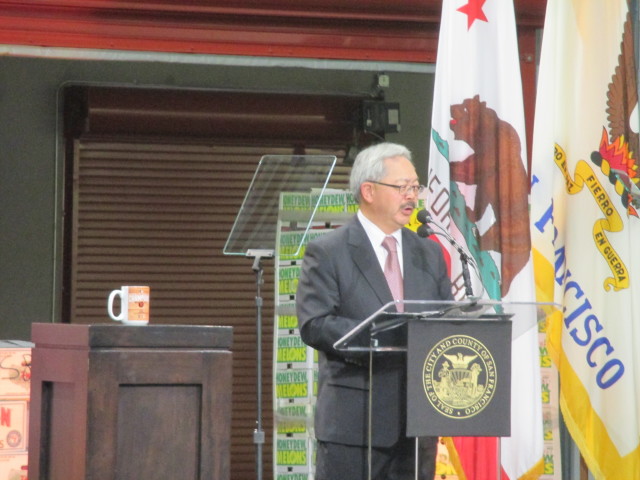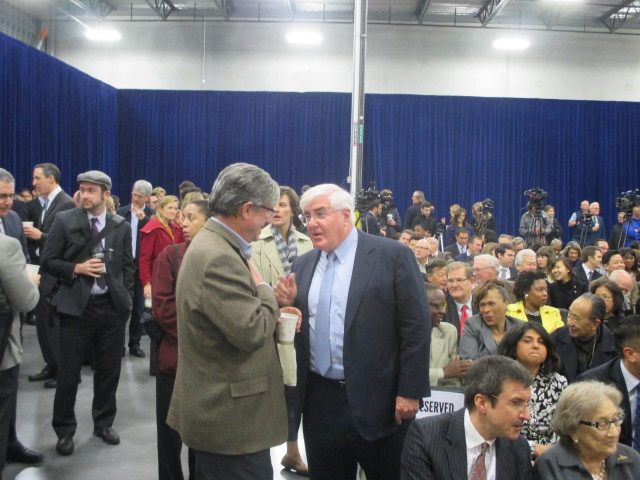The mayor’s State of the City address stressed housing — but his actual record is dismal and his proposals won’t work

By Calvin Welch
JANUARY 15, 2015 — The themes of Ed Lee’s re-election campaign were outlined in today’s State of the City address. At center place were the essentially defensive proposals to address the affordable housing crisis that grips San Francisco. His all-too-familiar initiatives — down payment assistance for middle class home owners, calls for private sector and foundation financing at never-mentioned levels, and a general obligation bond — remain unchanged from the Gavin Newsom Administration.
So much for “disruption” and “innovation” he and his backers love to yammer on about.
But then again, what can he do if, in fact, his policies are part of the problem and not a solution?
Let’s stipulate that a significant cause of the affordability crisis facing San Francisco and every other major American city has its roots in the failure of federal and state governments to maintain historic support for inner-city affordable housing development. A Republican Party intent on making government fail and a Democratic Party divided between populist and business wings has meant that government investment in urban infrastructure, of which affordable housing is a primary component, has virtually ceased.
The major housing subsidy now provided by the federal government – the mortgage interest rate tax deduction — is aimed at middle and upper-middle income homeowners — the very folks Ed Lee wants to help. In 2011, that tax break cost the federal government $72 billion, which was more than 70 times greater than the $1 billion the federal government spent to build new affordable housing that year.
But what makes the San Francisco crisis so devastating and so out of control is the local impact of rapid income disparity between the service/retail sector and the technology sector of our economy. The main manifestation of that disparity is the cost of housing.
Help us save local journalism!
Every tax-deductible donation helps us grow to cover the issues that mean the most to our community. Become a 48 Hills Hero and support the only daily progressive news source in the Bay Area.
Through a combination of embracing the most economically stratified sector of the modern urban economy – technology — and adopting a pro-market development policy , Ed Lee is equally responsible for the most devastatingly destructive affordable housing policy disaster since the days of redevelopment, when more than 10,000 homes were demolished in an effort to change the economic and demographic character of the city.
While presiding over a 10 percent increase in the employed workforce in the city since 2011, Ed Lee has also seen a 61 percent increase in the median price of a single family home over the same period.
Lee’s policies are so out of whack that his constant boasting of the “the highest minimum wage in the nation” is undercut by the fact that it would take TWO minimum wage earners paying 100 percent of BOTH of their incomes to afford the 2014 “housing wage” of $37 an hour to afford to rent the averaged priced two-bedroom apartment in San Francisco.
This is no surprise; we’ve seen it before
It not like this didn’t happen before. We all went through the same thing during the dotcom boom/bust from 1995 to 2000: A rapid increase in employment — 23 percent — and a rapid increase in housing costs 56 percent increase in the median price of single family home.
But with the bust in 2000, the next five years saw 63,000 of those jobs disappear and, a little later, with the “Great Recession,” housing prices began to drop, reaching their lowest point in 2009, 24 percent below the peak.
After the dotcom bust/boom, observers and researchers begin to recognize the relationship between the rise of the technology sector and the increase in income disparity.
A 2003 report prepared by the National Bureau of Economic Research and a 2008 IMF report both drew a relationship between the rise of the technology sector and increasing “income inequality.” Indeed, much of the debate on the community side over the rezoning of the formally industrial areas of the eastern San Francisco – the Eastern Neighborhoods Plan — from 2002 on was informed by the experience of the tech boom, and sought to preserve resident-employing light industrial, arts , and production uses.
Those policies were resisted by SPUR and the Newsom administration seeking new areas for market-rate housing and the “new economy” (then thought to be biotech. Community veterans of the tech-boom fight had learned the hard lesson of the relationship between jobs (income) and housing and sought new policies that linked market -rate housing development with increased affordable housing requirements and office use allowed only if arts, production, nonprofit or light industrial space was linked and also made available. These policies were rejected or reduced in the final plan approved Newsom’s Planning Commission.
The point here is that the impact of a rapid increase in a tech workforce on housing costs was well known, and there were ideas on the table about how to mitigate that impact. The fact that Lee not only did not apply those lessons and policy innovations but that he and his administration actively opposed them resulting in an even more wild swing in housing costs and attendant tenant and community displacement.
The first indication of the Lee Administration disinterest in creating a robust affordable housing financing program aimed at exactions from market rate developers appeared in his first year as mayor and the debate over the proposed construction of a giant new hospital on Van Ness Avenue.
Sutter-CPMC was the most profitable hospital chain in San Francisco and California. It was proposing a massive expansion in an area long zoned for “smart growth” with requirements for mixed-use housing and commercial development along a transit corridor.
The health care chain was proposing a commercial use, with no housing and a 10,000-car garage, at the intersection of Van Ness and Geary, a primary transit hub in San Francisco. There were extremely important health-policy issues as well — CPMC had taken over St. Luke’s hospital in the Mission and was wildly believed to want to close it in favor of “consolidation” at the new location.
The project offered Lee the chance to create jobs for residents, get payments for affordable housing and public transit, and leverage the preservation of St. Lukes. He failed in three of the four areas. He actually agreed to let CPMC provide half of the housing requirements forced on the hospital by community advocates for an ownership program with buyers chosen by CPMC management — rejecting the community position for permanently affordable rental housing opportunities open to all San Franciscans.
He showed no interest in resident job creation or meaningful transit mitigation.
After the deal fell apart once Lee found out CPMC was planning to close St Luke’s, the community/labor coalition got some $30 million in housing impact fees paid to the city as part of the final deal worked out with the Board of Supervisors.
Affordable housing task force
The second failure of the Lee administration to address a robust affordable housing program came in the near year-long talks called by the mayor to create an affordable housing trust fund, finally passed as Proposition B in 2012. It what became his signature style, Lee and his advisors assembled an huge and totally unworkable “task force” representing “all stakeholders” to come up with a “consensus” proposal for replacing the lost federal and state revenue for affordable housing development.
For much of the last decade, the city had put about $50 million a year into affordable housing development, with the largest portion being tax-increment financing from the Redevelopment Agency. Gov. Brown, who had repeatedly stated that affordable housing was one of the causes of Oakland’s crime rate, was in the process of repealing the use of the state portion of the property taxes used by redevelopment agencies and to redirect them to public education while he raided state funds then used for education in order to balance the state budget. That repeal would cost the city some $20 to $30 million a year. The job of the Task Force was to find a local replacement for that money.
The Council of Community Housing Organizations, made up of the non-profit developers of the City’s affordable housing stock, had proposed a general fund set-aside for an affordable housing fund in 2008, Proposition B which would have raised some $3 billion over its 15-year proposed life. Newsom, stung by CCHO member criticism of his failed homeless and development policy, adamantly opposed the measure and succeeded in its narrow defeat. CCHO proposed a repeat to Mayor Lee.
But developers wanted something in exchange for their support. They wanted a cap on all future market-rate housing fees for affordable housing. Indeed, in exchange for supporting the trust fund, they wanted no new fees at all for market-rate development.
What then ensued was a very long and detailed series of conversations between market-rate developers and affordable housing developers with the rest of the task force left out of the picture. It became clear was that the mayor was supporting the market-rate developers’ position and was seeking to de-link market-rate development from affordable housing development, a policy shift from the former four administrations.
In addition, the mayor then linked his support for the Housing Trust Fund to the passage of a new gross-receipts business tax that was set to be on the ballot on the same November, 2012 election. For the first time, many of us saw the influence of billionnaire tech investor Ron Conway at the policy level in the Lee administration, as the tax proposal was massaged to give breaks to large tech firms at the expense of small businesses.

A new set of “linkages” emerged: tech tax breaks and fee caps on market rate housing developers. Both measures, the gross receipts tax and the housing trust fund, historic “progressive issues” passed, but each in a new, far from “progressive” form.
The third failure to embrace a full-throated affordable housing policy occurred in 2013 around the issue of converting Tenancies in Common (TIC’s) into condominiums. During the Housing Trust Fund discussions, Supervisor Scott Wiener, taking note of the market-rate developers’ ability to move the mayor, demanded that as a condition of his support for the Housing Trust Fund his allies, the realtors, needed something as well — and that was the approval of thousands of existing TIC’s to be allowed to go to the head of the line and be converted into condominiums. CCHO strongly objected to this “linkage” and prevailed.
However, by March of 2013 Wiener introduced an ordinance to allow 10,000 existing TIC to convert to condos. He would charge them a fee, later to be only used for “homeownership” programs.
San Francisco had long limited the number of condo conversions of apartments to no more than 500 year. State law prohibited TICs from being considered condos, so there was no limit on the number of rental apartments that could be converted to TICs.
The problem for TIC owners (and TIC speculators) was that TIC’s aren’t as easy to sell as condo’s and they did not want to wait in line for the annual limit.
Tenants and affordable housers objected to TIC being allowed to be converted because TIC’s were created by selling rent-controlled buildings. Rent controlled apartments were “cheaper” than non-rent controlled buildings and thus were cheaper to convert and buy as TIC’s. Allowing the TIC/condo conversion would only lead to more TIC conversion and more loss of rent controlled units.
Mayor Lee made it known that he had no real objection to the legislation and thus Wiener had a political “hunting license” to round up six votes. A seven-month battle ensued between Wiener and tenant and affordable housing advocates. When six votes were found for a conversion process that was capped and limited and would suspend the 500 annual conversions until all of the TIC’s were converted, Lee let it be known that six votes weren’t enough and that eight votes would be required. Key areas of the legislation had to be weakened to get Supervisors London Breed and Malia Cohen to join the six. He then allowed the legislation to be approved without his signature.
The fourth example of the mayor’s preference for tech and the private market over an effective affordable housing policy is his full blown support for Short Term Rentals, the housing preference of Airbnb investor and mayor’s main political pal, Ron (Waterboard-‘Em-All) Conway.
Hotel rooms everywhere
Until the passage of Supervisor David Chiu’s ordinance in October, 2014, it was illegal for any housing unit that wasn’t a permitted hotel or a bed and breakfast to rent to anyone for less than 30 days. Planning staffers have allowed that the Mayor’s Office has directed the department to enforce that law only if there are complaints. Since most folks have no way of knowing which units are being rented for less than 30 days and thus don’t complain about what they don’t know, enforcement of the law is simply ignored.
In addition, Lee two years ago strongly urged the Treasurer not to collect any hotel taxes from Airbnb or any of the other “sharing economy” innovations in the hotel business.
The legislation that Lee supported and signed allows every residential unit in San Francisco to be a hotel room by changing the definition of “residential use.” By making a distinction between “hosted” and “unhosted” rentals, a distinction the city can’t enforce without being present at all times in all homes, the law allows STR’s 365 days a year.
There are now some 10,000 units listed on VRBO or Airbnb in San Francisco and more than 60 percent of them are rented as full apartments, with no “sharing” at all with “home sharers.” They are hotel rooms in residential buildings in residential neighborhoods. This simply leads to the loss of long-term residences — directly adding to the city’s housing shortage at a time of peak demand. It would take more than Ed Lees entire $250m housing bond to simply replace these units lost to STR’s.
I could go on to list the mayor’s unwillingness to allocate sufficient funds to rehabilitate public housing while repeatedly saying how committed he is to do so. Or his administration’s total refusal to make the Art Institute stop its conversion of hundreds of housing units to “student housing” and pay for the replacement of the permanent units already converted.
The Lee administration has seen the lowest percentage of affordable to market-rate housing ratios (less than 25 percent ) of any of the last three administrations. The Lee administration has allocated less local funds to for permanently affordable housing production than three of the last four administrations. The Lee administration has seen the largest reduction of rent-controlled units of any administration since the passage of rent control in 1979.
Ed Lee’s affordable housing performance has been appalling, and with his near certain re-election, it becomes our responsibility to place directly before the voters of this city measures which will correct that dismal record and stop Lee from making an already difficult problem even worse.





